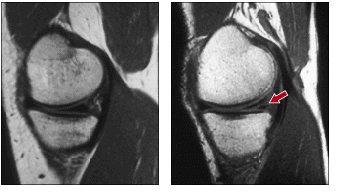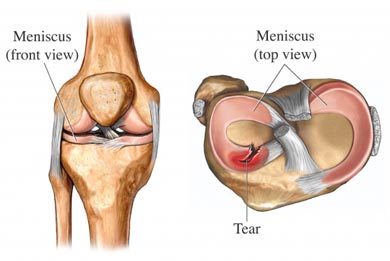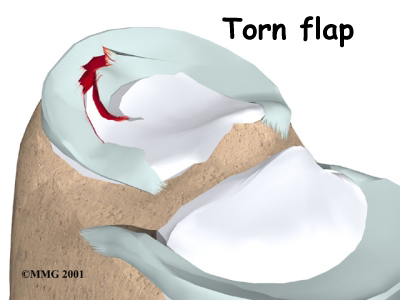Apley's Test: Difference between revisions
No edit summary |
No edit summary |
||
| Line 14: | Line 14: | ||
== Test Description <br> == | == Test Description <br> == | ||
Appley's grinding test involves placing the patient in the prone position with the knee flexed to 90 degrees<ref | Appley's grinding test involves placing the patient in the prone position with the knee flexed to 90 degrees<ref>Christopher Norris (2004). Sports Injuries: Diagnosis and Management, Third Edition. Butterworth-Heinemann.</ref>. The patient's thigh is then rooted to the examining table with the examiner's knee. The examiner laterally and medially rotates the tibia, combined first with distraction, while noting any excessive movement, restriction or discomfort. The process is then repeated using compression instead of distraction<ref name="Magee" />. If rotation plus distraction is more painful or shows increased rotation relative to the normal side, the lesion is most likely to be ligamentous<ref name="Magee" />. If the rotation plus compression is more painful or shows decreased rotation relative to the normal side, the lesion is most likely to be a meniscus injury<ref name="Magee" />. | ||
== Reliability of The Test == | == Reliability of The Test == | ||
Revision as of 11:56, 28 May 2009
Please do not edit this page unless you are part of the RCSI student project.
Note to editors: This page will be opened up again for public editing when the project is complete.
Note to RCSI students: please leave this notice here for the duration of the project and copy it into any new pages that you create.
Original Editor - Tom Whyatt, Eilis Fitzgerald, Faisal Alanezi, Abdulkareem Almutairi, Sinead McCarthy, Conor McHugh (RCSI Student Project).
Lead Editors - Your name will be added here if you are a lead editor on this page. Read more.
Background to Appley's
[edit | edit source]
The Appley's grind test is used to evaluate individuals for problems of the meniscus in the knee. This test is named after Alan Graham Appley (1914 - 1996), a British orthapedic surgeon, who discovered this assessment technique[1].Diagnosis of meniscal injuries can be difficult as the menisci are avascular and have no nerve supply on their inner two thirds, resulting in very little pain or swelling when an injury occurs[2]
Test Description
[edit | edit source]
Appley's grinding test involves placing the patient in the prone position with the knee flexed to 90 degrees[3]. The patient's thigh is then rooted to the examining table with the examiner's knee. The examiner laterally and medially rotates the tibia, combined first with distraction, while noting any excessive movement, restriction or discomfort. The process is then repeated using compression instead of distraction[2]. If rotation plus distraction is more painful or shows increased rotation relative to the normal side, the lesion is most likely to be ligamentous[2]. If the rotation plus compression is more painful or shows decreased rotation relative to the normal side, the lesion is most likely to be a meniscus injury[2].
Reliability of The Test[edit | edit source]
Many studies have attempted to quantitate the reliability of various physical examination findings. In a prospective study comparing preoperative joint line tenderness to arthroscopic findings of meniscal tears, the sensitivity of joint line tenderness was found to be 86% and 92% with an overall accuracy rate of 74% and 96% for the medial and lateral meniscus, respectively, another study found similar results, with joint line tenderness having a sensitivity of 74%. The only significant McMurray sign to correlate with a meniscal injury was a “thud” elicited on the medial joint line with a medial meniscal tear. However, the McMurray and Apley tests were found by others to have less than 75% sensitivity for diagnosing meniscal tears.5
Sensitivity of the Test
[edit | edit source]
Diagnostic accuracy studies of meniscal tests are described to have poor methodologic quality with highly heterogeneous results, therefore poor value for clinical practice.6 A recent meta-analysis reports sensitivity and specificity to be 60% and 70% respectively.7
[edit | edit source]
Graphics/ Photos[edit | edit source]
 9. MRI showing Normal Meniscus Vs Torn Meniscus
9. MRI showing Normal Meniscus Vs Torn Meniscus
Recent Related Research (from Pubmed)[edit | edit source]
Extension:RSS -- Error: Not a valid URL: Feed goes here!!|charset=UTF-8|short|max=10
References[edit | edit source]
References will automatically be added here, see adding references tutorial.
- ↑ Alan Graham Apley, available from Who Named It, www.whonamedit.com/doctor.cfm/203.html [last accessed 28/5/9]
- ↑ 2.0 2.1 2.2 2.3 David J. Magee (2002). Orthopedic Physical Assessment. 5th Edition. W.B. Saunders, London.
- ↑ Christopher Norris (2004). Sports Injuries: Diagnosis and Management, Third Edition. Butterworth-Heinemann.
1. www.whonamedit.com/doctor.cfm/203.html
2. David J. Magee Orthapedic Physical Assessment Fifth Edition
3. David J. Magee Orthapedic Physical Assessment Fifth edition
4. Christopher Norris Sports Injuries: Diagnosis and Management Third edition
5. Current diagnosis & treatment in sports medicine By Patrick J. McMahon
6. Scholten RJ, Deville WL, Opstelten W, Bijl D, van der Plas CG, Bouter LM.The accuracy of physical diagnostic tests for assessing meniscal lesions of the knee: a meta-analysis. J Fam Pract. 2001; 50:938-944.
7. Hegedus EJ, Cook C, Hasselblad V, Goode A, McCrory DC. Physical examination tests for assessing a torn meniscus in the knee: a systematic review with meta-analysis. Journal of Orthopaedic and Sports Physical Therapy, 2007; 37(9), 541-50.
Images:
8. http://services.epnet.com/getimage.aspx?imageiid=7305
9. http://www.athleticadvisor.com/images/LE_images/knee/Meniscus_MRI.gif
| The content on or accessible through Physiopedia is for informational purposes only. Physiopedia is not a substitute for professional advice or expert medical services from a qualified healthcare provider. Read more. |








